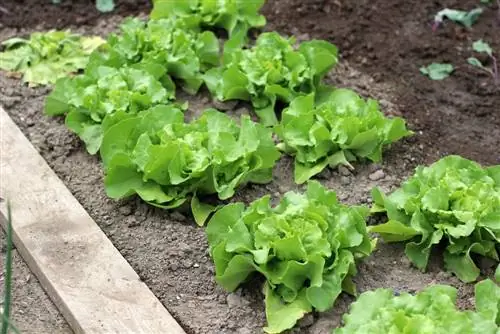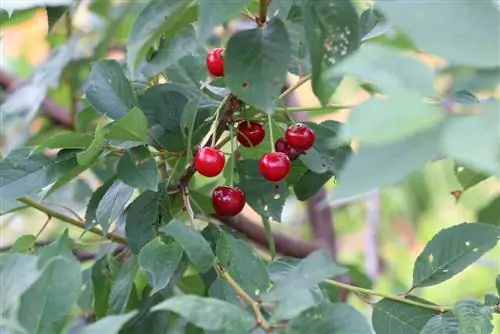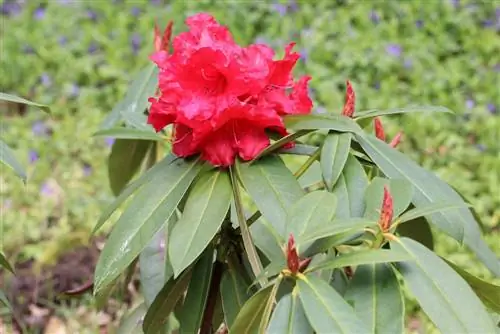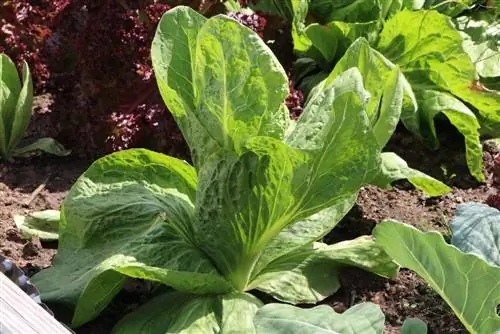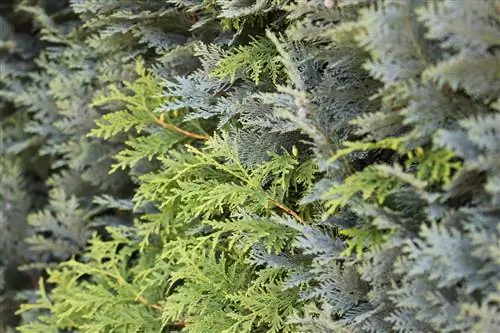- Author admin [email protected].
- Public 2023-12-17 03:39.
- Last modified 2025-01-24 12:45.
Lettuce is not only popular with amateur cooks, many hobby gardeners also swear by this classic among the various types of lettuce. If you decide to sow every 3-6 weeks, you can harvest fresh lettuce at any time during the season. The crop, which is very fast-growing, is suitable for spring sowing and summer sowing, depending on the desired variety. There are varieties that shoot up very quickly and open up, while others grow very slowly in contrast to the fast-growing varieties and with these the closed shape remains completely intact. Cultivation and care are quite simple, but as with any plant, mistakes can happen that can result in the total loss of the plants. Therefore, some valuable tips for care are essential and should always be followed.
What needs to be considered when sowing
When sowing, you should make sure that you choose a variety that suits the season. If a spring variety is planted in summer, the lettuce shoots up very quickly and is susceptible to pests and fungal diseases. Therefore, when buying seeds or young plants, you should choose a variety that is resistant to diseases.
Sowing spring varieties
When sowing spring plants, the seeds must be placed directly in the soil. Since the lettuce belongs to the family of light germinators, it is then covered with a little soil. It is important to ensure that the difference between the temperatures during the day and at night is no more than 5 degrees. A temperature of 12 degrees to 16 degrees is ideal for germination. The germs must then receive an even moisture content so that they do not dry out.
The summer varieties must be pre-germinated
For the summer varieties, the seeds must be pre-germinated; this can best be done in a kitchen towel. To do this, place the seeds in the refrigerator with kitchen paper for 2 days and only then put them into the bed. The heat in summer prevents seeds from germinating outside. As soon as the plants are large enough, they are staggered individually at a distance of 25 cm.
Young plants as an alternative to seeds
If you don't dare to sow seeds, garden stores will have young plants available from spring. These can be planted very early under glass or foil. In order to prevent the soil and plants from molding in sunny weather, the area should be ventilated regularly so that air exchange can take place. If you want to plant the young plants directly in a bed, you have to be patient until the ground is completely frost-free. The location must be chosen carefully as lettuce needs a sunny spot. The soil should be pretreated so that it is not only rich in nutrients, but also very loose and permeable.
The young plants can then be planted at a distance of approximately 25 cm. The plants should not be planted too deep, otherwise they can rot very quickly. Once the plants have been planted in the right location, they need to be watered regularly. The soil must always be kept moist, but every gardener should not use too much water.
Caring for plants
Caring for lettuce, on the other hand, is very easy. The plants need to be watered regularly so that the leaves do not become too hard. However, when watering, care should be taken to only water the soil and not the plants. As soon as the typical heads form from the young plants, watering should be reduced. So that the soil can retain moisture better, it is recommended to create a layer of mulch around the plants. The mulch also keeps annoying weeds away.
Compost is an excellent fertilizer, so you don't need to use any additional fertilizer. However, stable manure is very unsuitable; even if the soil has already been fertilized, it must not be fertilized again. Otherwise the plants become susceptible to diseases and pests. When growing in containers, it is recommended to use special vegetable soil as it is already fertilized.
Care is not just about correct watering; it is recommended if a lettuce is already resident against pests and some fungal diseases. Numerous dangers lurk in the vegetable patch, the most common being the slug. She likes the taste of the lettuce. However, you can get this problem under control again with simple means. If you can see snails on the lettuce, it is enough to simply pull them off and put them in another corner of the garden. A net that can be stretched over the bed significantly reduces the number of snails visiting. Therefore, every gardener who wants to grow lettuce should also plan such nets.

If other pests have attacked the lettuce, no one should immediately resort to chemicals. After all, the chemicals used will later be consumed through food. There are numerous biological remedies that can work wonders on such pests. The situation is different with fungal diseases; in this case the lettuce can usually no longer be saved and has to be thrown away. The most common reason for a fungal disease is the pH value of the soil. This must be balanced; lettuce in particular requires a PH value of more than 5.5 percent. The PH value can be regulated again with humus and special soil so that other lettuce plants do not suffer.
Enjoy your own cultivation
If a hobby gardener follows these important basics for growing and caring for lettuce, nothing stands in the way of a productive harvest. Even minor setbacks shouldn't set anyone back; in fact, you can learn valuable things from the mistakes you make.
Growing Tips
Since lettuce germinates and grows very quickly, it provides fresh greens on the lunch table in the cool months. Sowing outdoors should not begin until the end of April, and the seeds should be covered with fleece. Young and adult lettuce plants are often attacked by snails. However, there are now also snail-resistant varieties available to buy. If you have a lot of snails in your garden, you might want to use these varieties. This saves you a lot of work and nerves. Apart from parsley and celery, lettuce grows alongside almost all plants, including in mixed cultures. Greenhouse varieties are slightly more contaminated with nitrates than outdoor varieties. The darker outer leaves are richer in vitamins than the slightly yellowish heart, which is why they taste a little more bitter. The heart, with the yellowish to light green leaves, tastes milder and sometimes even a little sweeter.
Children especially like lettuce hearts as a side dish to meat dishes, because they don't taste so bitter. Lettuce likes humus-rich soil in a sunny location. Harvesting can take place continuously, depending on needs. Some varieties can also be harvested as young plants (without a developed head) and prepared as a salad. If you really like having green salad on your table, pick lettuce is also a good option; it tastes almost exactly the same as lettuce, just a little milder. Lettuce leaves must be washed before preparation. Soil tends to build up between the leaves. Snails also like to leave their traces between the leaves. However, the individual leaves can be cleaned very easily under cold running water and the cold water keeps the lettuce leaves fresh and crisp for a little longer.

